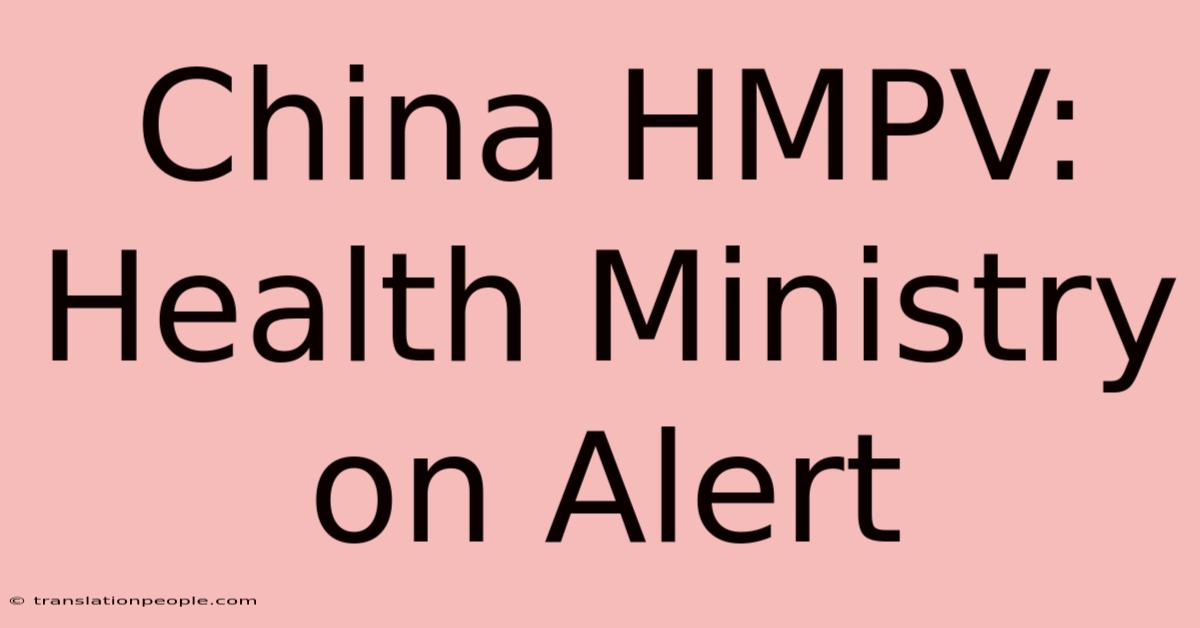China HMPV: Health Ministry On Alert

Discover more detailed and exciting information on our website. Click the link below to start your adventure: Visit Best Website nimila.me. Don't miss out!
Table of Contents
China HMPV: Health Ministry on Alert
Editor’s Note: Concerns regarding a surge in Human Metapneumovirus (HMPV) cases in China have prompted a heightened alert from the Health Ministry. This article explores the situation, its implications, and what you need to know.
Why This Matters
China's Health Ministry's alert regarding a rise in Human Metapneumovirus (HMPV) infections is significant for several reasons. HMPV, a common respiratory virus, usually causes mild cold-like symptoms. However, in vulnerable populations like infants, the elderly, and those with compromised immune systems, it can lead to severe respiratory illnesses requiring hospitalization. The current surge raises concerns about potential strain on healthcare resources and the overall public health impact. Understanding the virus, its transmission, and preventative measures is crucial for mitigating its spread and protecting vulnerable individuals. This situation highlights the ongoing need for robust public health surveillance and rapid response mechanisms to emerging infectious disease threats.
Key Takeaways
| Point | Description |
|---|---|
| HMPV Surge in China | The Health Ministry has issued an alert regarding a notable increase in HMPV cases. |
| Vulnerable Populations | Infants, the elderly, and immunocompromised individuals are at higher risk. |
| Symptoms | Similar to a common cold, but can be severe in vulnerable groups. |
| Prevention | Good hygiene practices, vaccination (where available), and early medical attention are key. |
| Ministry's Response | The Health Ministry is actively monitoring the situation and coordinating responses. |
China HMPV: Understanding the Situation
The recent increase in HMPV cases in China has prompted a timely response from the Health Ministry. While HMPV infections are common globally, this surge underscores the unpredictable nature of respiratory viruses and the importance of ongoing vigilance. The specific reasons behind this increase are still under investigation, but factors such as seasonal changes, waning immunity post-COVID, or the emergence of a new variant are potential contributing factors. The situation necessitates a close monitoring of the virus's spread and its impact on the healthcare system.
HMPV Transmission and Symptoms
HMPV spreads through respiratory droplets produced when an infected person coughs or sneezes. Close contact with an infected individual increases the risk of transmission. Symptoms typically include fever, cough, runny nose, sore throat, and headache. In severe cases, particularly among high-risk individuals, HMPV can lead to bronchiolitis (inflammation of the small airways in the lungs) and pneumonia. Early detection and medical attention are crucial for managing severe cases.
Protecting Yourself and Others from HMPV
The best way to protect yourself and others from HMPV is through practicing good hygiene. This includes frequent handwashing, covering coughs and sneezes, and avoiding close contact with sick individuals. Vaccination, while not always widely available for HMPV, can offer protection in some cases, particularly for high-risk groups. Seeking medical attention promptly if you develop severe symptoms is vital for effective treatment and preventing complications.
People Also Ask (NLP-Friendly Answers)
Q1: What is HMPV?
A: HMPV, or Human Metapneumovirus, is a common respiratory virus that causes cold-like symptoms.
Q2: Why is the HMPV surge in China important?
A: The surge highlights the potential strain on healthcare systems and the need for robust public health responses to emerging respiratory illnesses. Vulnerable populations are particularly at risk.
Q3: How can HMPV affect me?
A: Most people experience mild cold-like symptoms. However, infants, the elderly, and those with compromised immune systems are at higher risk of severe respiratory illness.
Q4: What are the main challenges with the HMPV outbreak?
A: Challenges include the potential for overwhelming healthcare resources, particularly in regions experiencing a significant surge in cases, and ensuring sufficient access to treatment for vulnerable populations.
Q5: How to get started with protecting myself from HMPV?
A: Start by practicing good hygiene: frequent handwashing, covering coughs and sneezes, and avoiding close contact with sick individuals. Consult your doctor about vaccination options if available.
Practical Tips for Preventing HMPV
- Wash your hands frequently: Use soap and water for at least 20 seconds, or use an alcohol-based hand sanitizer.
- Cover coughs and sneezes: Use a tissue or your elbow to cover your mouth and nose.
- Avoid close contact: Maintain a safe distance from sick individuals.
- Stay home when sick: Avoid spreading the virus by staying home and resting.
- Clean and disinfect surfaces: Regularly clean and disinfect frequently touched surfaces.
- Get vaccinated (if available): Consult your doctor about vaccination options.
- Practice healthy habits: Get enough sleep, eat nutritious food, and manage stress.
- Seek medical attention: If you experience severe symptoms, such as difficulty breathing, seek immediate medical attention.
Summary: The recent increase in HMPV cases in China underscores the importance of public health preparedness and individual preventative measures. Staying informed, practicing good hygiene, and seeking medical attention when needed are crucial steps in protecting yourself and your community.
Call to Action
Stay informed about the latest developments regarding HMPV in China and other regions. Share this information with friends and family to help raise awareness and promote preventative measures.
Hreflang Tags (Example - Adapt for all relevant languages)
<link rel="alternate" hreflang="en" href="https://example.com/en/china-hmpv-alert" />
<link rel="alternate" hreflang="zh-CN" href="https://example.com/zh-CN/china-hmpv-alert" />
(Note: Replace example URLs with actual URLs.)

Thank you for visiting our website wich cover about China HMPV: Health Ministry On Alert. We hope the information provided has been useful to you. Feel free to contact us if you have any questions or need further assistance. See you next time and dont miss to bookmark.
Featured Posts
-
Meghan Markles Show Premiere Date And Guests
Jan 03, 2025
-
Sugar Bowl Notre Dame Victory
Jan 03, 2025
-
9 Ravens 7 Lions Make Pro Bowl
Jan 03, 2025
-
Notre Dame Vs Penn State Odds 2025 Orange Bowl
Jan 03, 2025
-
Winter Storm Blair Update Snow Ice
Jan 03, 2025
